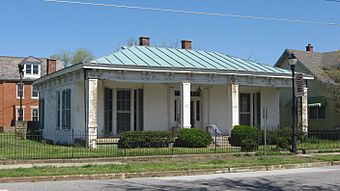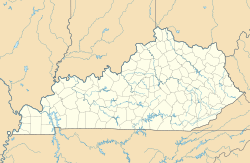David Yeiser House facts for kids
|
Mayor David A. Yeiser House
|
|
|
U.S. Historic district
Contributing property |
|

Front of the house
|
|
| Location | 533 Madison St., Paducah, Kentucky |
|---|---|
| Area | Less than 1 acre (0.40 ha) |
| Built | 1852 |
| Architectural style | Greek Revival, Italianate |
| Part of | Lower Town Neighborhood District (ID82002736) |
| NRHP reference No. | 73002130 |
Quick facts for kids Significant dates |
|
| Added to NRHP | March 7, 1973 |
| Designated CP | March 15, 1982 |
The David Yeiser House is a special old home in Paducah, Kentucky. This city is in the far western part of Kentucky. The house was built in the 1850s. It is named after David A. Yeiser, who was once the mayor of Paducah. He helped make many good changes in the city.
This house is one of the few Greek Revival style homes in Paducah built before the 1860s. It stands on land where a battle took place during the American Civil War. Most other houses nearby were destroyed in that battle. The David Yeiser House has been recognized as an important historic site.
Contents
Who Lived in the Yeiser House?
The house was built in 1852 for William Smedley. He owned a wharf boat on the Ohio River in Paducah. He also sold supplies for boats.
Later, David A. Yeiser bought the house. He was a pharmacist (someone who prepares and sells medicines) and a politician (someone involved in government). David Yeiser was mayor of Paducah for thirteen years. During his time as mayor, the city got its first sewers. It also had its first electric streetlights. Some of the main streets were paved too.
The Alben W. Barkley Museum
After a while, the Yeiser House started to get old and worn down. It was then fixed up and turned into a museum. The Young Historians Association of Paducah ran the museum. This group was made up of students from local high schools and middle schools. Adults helped guide them. The students created exhibits and taught visitors about the history.
The museum mostly focused on Alben W. Barkley, who lived in Paducah. He was the Vice President of the United States under President Harry S. Truman. The museum showed things like Barkley's hat and his vice-presidential desk. There were also photos of him meeting important people, like the Pope.
Even though it was called the Alben W. Barkley Museum, it also had other exhibits. A smaller part of the museum was about Linn Boyd. He was also from Paducah and served as the Speaker of the United States House of Representatives for four years.
The House's Design and History
The area where the house is, called the Lower Town Neighborhood District, became part of Paducah in 1836. The buildings in this neighborhood look very different from each other. Some are in the older Greek Revival style. Others are in the later Queen Anne style. Many simple, everyday homes like shotgun houses are also there.
Surviving the Civil War Battle
Very few buildings in this area were built before the 1860s. This is because of the American Civil War. The Battle of Paducah happened right in this neighborhood. Soldiers from the Confederate Army tried to attack Fort Anderson. This fort was controlled by the Union Army.
After the Confederate soldiers were pushed back, the Union commander gave an order. He told his soldiers to destroy nearby houses. This was to stop future attackers from hiding in them to get close to the fort. The Yeiser House was one of the few buildings that survived this battle. Like most of the other surviving homes, it is in the Greek Revival style. It has a special covered porch on the front, which was unusual for Kentucky houses at that time.
What the House Looks Like
The Yeiser House is one story tall. It is made of brick. It has a low, sloped roof called a hip roof. Two chimneys stick up from the roof. The walls are very thick, about one foot (30 cm) wide. The front of the house has three sections, called bays.
Architectural Styles and Features
You can see both Greek Revival and Italianate styles in the house. Fancy brackets decorate the roof of the front porch. These brackets form a cornice (a decorative molding). Four square brick columns hold up the porch. The porch is about 9 feet (2.7 meters) deep and 50 feet (15 meters) wide.
The main door is in the front. It has narrow windows on the sides, called sidelights. There is also a window above the door, called a transom window. Two decorative flat columns, called pilasters, frame the entrance.
Changes Over Time
The front of the Yeiser House looks almost the same as it did when it was new. But the back of the house looks quite different. In the 1940s, a porch on the west side was closed in. It became part of the house. One of the original chimneys was also removed.
Inside, even bigger changes were made at that time. Two fireplaces were taken out. The bathroom was updated. All the old furniture was replaced with new pieces.
Protecting This Historic Home
In March 1973, the Yeiser House was added to the National Register of Historic Places. This means it is a very important historic building. It qualified because of its unique architecture and its connection to David A. Yeiser. It was the first place in McCracken County to get this special honor.
The Yeiser House is also a key part of the Lower Town Neighborhood District. This district includes many historic buildings. The Yeiser House is one of the most important "contributing properties" in this historic district.
The Museum's Closure
Even with its historic status, the Alben W. Barkley Museum is no longer open. A history teacher had worked hard to support the museum. They used their own time and money to keep it going. But in 2008, the money ran out, and the museum had to close.
The city bought the building. The items from the museum were divided up. Some went to the museum in the Market House downtown. Other items went to different museums.



